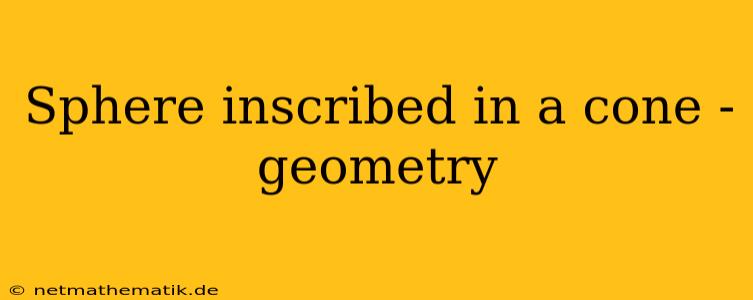The concept of a sphere inscribed within a cone is a fascinating exploration in geometry, blending the properties of both shapes to create a unique and visually appealing scenario. This article will delve into the relationship between these geometric figures, examining the key principles and formulas that govern the interaction between a sphere and its enclosing cone. We will explore the conditions under which a sphere can be inscribed, analyze the relationship between the sphere's radius and the cone's dimensions, and uncover the intriguing geometric consequences of this arrangement.
Understanding the Geometry: Sphere Inscribed in a Cone
Imagine a cone, its apex pointing towards the sky, and a perfectly round sphere nestled within its hollow. This sphere, touching the cone's base and its slanted sides, fits snugly inside, defining a special relationship between the two figures. This arrangement, where a sphere is inscribed within a cone, presents a captivating geometric challenge, requiring an understanding of both the sphere's properties and the cone's unique characteristics.
Key Terminology
Before we dive into the details, let's define some essential terms:
-
Sphere: A sphere is a perfectly round three-dimensional object where every point on its surface is equidistant from its center. Its radius, denoted by 'r', is the distance from the center to any point on the sphere's surface.
-
Cone: A cone is a three-dimensional object formed by connecting a circular base to a point called the apex. The cone's height (h) is the perpendicular distance from the apex to the base. The slant height (l) is the distance from the apex to any point on the circumference of the base.
-
Inscribed Sphere: A sphere inscribed within a cone is a sphere that touches the cone's base and its slanted sides. The sphere's center coincides with the cone's axis of symmetry.
The Conditions for Inscription
Not every cone can accommodate an inscribed sphere. There are specific conditions that must be met for a sphere to be inscribed within a cone. These conditions involve the relationship between the cone's height (h), slant height (l), and radius (R) of its base.
-
Slant Height and Radius: The key condition is that the cone's slant height must be greater than the radius of its base (l > R). This ensures that the sphere has sufficient space to touch both the cone's base and its slanted sides without protruding.
-
Height and Radius: The cone's height must be greater than half its base's radius (h > R/2). This condition guarantees that the sphere's center will lie within the cone's interior.
The Relationship Between Sphere and Cone Dimensions
The radius of the inscribed sphere (r) is directly related to the dimensions of the cone. To understand this relationship, consider the following:
-
The Sphere's Center: The center of the inscribed sphere lies on the cone's axis of symmetry, and its distance from the base is equal to the sphere's radius (r).
-
Right Triangle Formation: Imagine a right triangle formed by the cone's height (h), the cone's radius (R), and the distance from the sphere's center to the base (r). This triangle, which is similar to a larger triangle formed by the cone's slant height (l), allows us to use the Pythagorean theorem to relate the dimensions.
-
Applying the Pythagorean Theorem: Using the similar triangles, we can set up the following proportion:
(R - r)/r = h/l
Solving this equation for the sphere's radius (r), we get:
r = (Rl)/(h + l)
This formula establishes a crucial connection between the sphere's radius and the cone's height, slant height, and base radius.
Geometric Implications of a Sphere Inscribed in a Cone
The inscription of a sphere within a cone leads to some intriguing geometric consequences:
-
Maximizing Volume: The sphere inscribed within a cone maximizes the volume of the sphere that can fit inside the cone. Any sphere with a larger radius would either protrude from the cone's surface or not touch the base.
-
Surface Area Relationship: The ratio of the surface area of the inscribed sphere to the lateral surface area of the cone is directly related to the dimensions of the cone. This ratio can be calculated using the formulas for sphere and cone surface areas, which are:
- Sphere Surface Area: 4πr²
- Cone Lateral Surface Area: πRl
-
Symmetry and Tangency: The symmetry inherent in the arrangement of the sphere and cone leads to important tangency properties. The sphere touches the cone's base at a single point, and it touches the cone's slanted side along a circle.
Applications and Examples
The concept of a sphere inscribed in a cone finds applications in various fields:
-
Engineering: The principle of inscribing a sphere within a cone can be applied in the design of storage tanks, silos, and other cylindrical structures to optimize their volume and minimize material usage.
-
Architecture: The architectural design of buildings often incorporates geometric shapes like spheres and cones, creating visually appealing and structurally sound structures.
-
Mathematical Modeling: The relationship between the sphere and cone can be used in mathematical modeling to represent physical phenomena, like the flow of fluids or the propagation of waves.
Conclusion
The concept of a sphere inscribed in a cone, while seemingly simple, presents a rich tapestry of geometric relationships and implications. Understanding these relationships allows us to analyze the properties of both the sphere and the cone, maximizing their potential within the constraints of the other. From the formula that links the sphere's radius to the cone's dimensions to the applications in engineering and architectural design, the inscribed sphere remains a captivating topic in geometry, reminding us of the elegance and power of mathematical principles.
